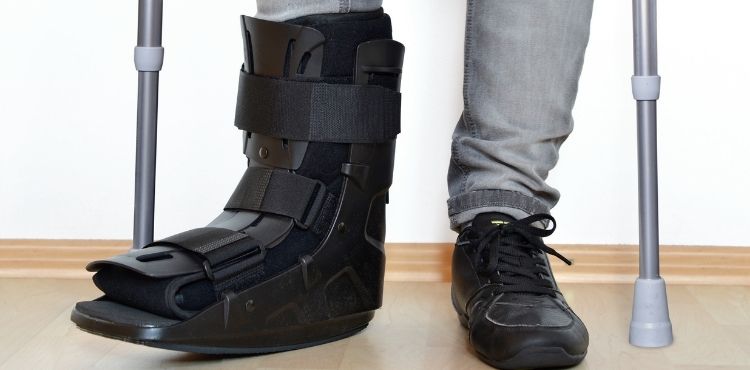A walking boot can bring back the pleasure of free movement. Also, it helps achieve a regular lifestyle like before when you did not need it. For this, some tips for wearing a walking boot can be helpful! We will talk about these tips in this article.
Life can turn from joyful to disheartening within moments. Nobody can say whether they meet any accident in the next second. The leg injury is such an unexpected event bringing changes to human life.
If you follow the proper instructions of wearing a walking boot, the wound will be covered sooner.
Contents
Definition of Walking Boot:

A walking boot is different from regular boots for walking or hiking. We need to wear them when we injure our foot, ankle, or even the lower leg. However, the typical materials of this boot are polypropylene or PVC.
The upper part of the boot covers most portions of the foot. The lower cuff protects the calf muscle. Hence, the walking boot has a massive role in gaining fit feet faster.
13 Helpful Tips for Wearing a Walking Boot
Looking for how to make a walking boot more comfortable? Well, you should follow these below tips:
1#. Must Listen to the Doctor
We know your doctor has suggested you wear a walking boot. After all, a doc or physio knows what is most suitable for you. You should take rest if they advise you. Consequently, they will tell you the time of wearing a boot.
In some cases, you should pause while moving on a walking boot. Otherwise, swelling may worsen the situation.
2#. Be Careful While Wearing the Boot
Once you are permitted to wear the boot, be careful when putting it on. Be careful when you are wearing socks. You can finish wearing them with the wounded part to secure it.
It helps to resist any stress on that part. Later, loosen all the straps when you remove the boot. It will give the foot sufficient space for better relaxation.
3#. Ignore Damp Boot
Always walk in a dry boot to keep your feet out of possible infections. The moisture of the wet boot can worsen the wound and may infect the area.
As a result, you may need to wait for a bit long time. While you are in the shower, cover the boot area with a waterproof plastic bag. It will prohibit water from entering the injured site and keep your foot dry.
5#. Walk Straight From the Knee
Most of the people with injured legs cause strain for their walking style. Remember, ligaments and tendons are connected to our entire leg. They are affected when you put every step.
But when you bend the knee while gaiting causes strain. So, you should roll your feet and walk straight from the knee to reduce the stress.
6#. Use a Shoe Balancer/Leveler
Have you thought of a shoe balancer or leveler? When you have worn a walking boot, the length of both legs becomes unequal.
So, your body alignment of the back, hip, and knee can cause colossal pain and stress. Wearing a shoe balancer with a walking boot can equalize limb length and solve these issues. It can increase height at 0.5”-2” approximately.
7#. Wear a Sock Liner
A sock liner is basically insertable thin sock-like stuff for walking boots. It helps keep feet cozy against the impact of boot and foot contact.
If you want a suggestion, you may purchase the Superfeet insoles to wear as sock liners. These insoles have sufficient breathability to keep your feet cool and dry.
8#. Be Careful on the Floor Surface
Mostly we ignore remaining careful while walking on regularly used floor surfaces. But when we are on different floors, it may cause more leg injury. Even some slippery surfaces can invite another injury.
So, you must be careful about walking on these surfaces as you care about the walking boot. After all, the walking boot may have less grip like other regular shoes.
9#. Take Shorter Steps
While you are on the walking boot, you should take shorter steps. It will have less impact on the wounded area.
Also, you can prevent back or hip pain from excessive shaking for the longer steps.
10#. Wear Good Fit Walking Boot
You already have a situation to wear a walking boot instead of a regular boot. So, you should follow tips to wear the right size or fit boot. Improper sizing can cause pain from swellings and hot spots. And you know feet get swellings when you walk.
Later, you get further infections to the feet. If you prefer a larger boot, your foot will slip or slide inside it. Alternatively, a shorter boot can be tighter to enter your foot in it. Even if you do so, you may harm your foot. So, choose snug boots for good fitting.
11#. Place feet higher than your heart
Sounds weird? But it works so well. Blood circulates well when you keep your feet higher than your heart.
Because keeping them low, blood flows faster to legs, and you will feel the pressure on feet. Heavy pressure on wounded legs may cause swellings. So, we suggest you place a pillow below the legs to elevate them. And you will feel better.
12#. Consider Wearing Socks
You may ask should I wear a sock with a walking boot? Well, it is a great tip for wearing a walking boot. Wearing without socks is possible, yet the hardness of the boot may make you feel discomfort.
But if you put on socks, the reduced friction between boot and feet skin can resist further blisters. Some people may suggest shock resisting shoe inserts if you don’t want to wear socks.
13#. Inspect Toe Tips and Heels Daily
Remaining conscious of toe tips and heels regularly is good for knowing the current condition of feet. You may check whether there is any redness or sores. Sometimes, there is no feeling around the feet where you use local anesthetics.
Again, if you see toes are purple, pale, or swollen toes, know that blood is not reaching them properly. For this, loosen the walking boot belt and contact your doctor.
Frequently Asked Questions About Wearing Walking Boot

A walking boot is definitely helpful to wear when we have injured legs. These are some most common questions when you search for tips on putting a walking boot:
What Clothes You Should Wear With a Walking Boot?
When you are in the treatment period of a broken ankle injured leg, you should wear comfortable things. We have found a Reddit user who was in almost six weeks wearing this boot. He suggested some tips like wearing low-to-mid heels rather than a flat or tennis shoe.
He also added to put on skirts and dresses as they are not tighter. Therefore, you can choose canvas, sandals, sneakers too for wearing with a walking boot. After all, it’s up to your comfy.
How Long Can You Walk in a Walking Boot?
One important thing you should know is that you should keep your feet out of any risks. Walking too long can increase the risk of swelling.
Again, it can delay the whole treatment process. However, you must follow all other tips to avoid walking boot discomfort. Take a rest if you face any difficulties while walking in a boot. Lastly, you should walk only after asking your doctor for betterment.
Do You Need Crutches When You Are on a Walking Boot?
People walking with crutches require using them for a long duration until they start walking properly. But it is not recommended for people using a walking boot.
These boots are wearable for an average of a couple of weeks only. Again, you can still use the crutches to reduce pressure on your legs. But it will teach your body depending on the crutches. Gradually, your body will forget to walk normally again.
Can You Work With a Walking Boot?
Again, it’s about getting well soon when you are in a walking boot. If you have a desk job requiring less walking or feet movement, you may work with a walking boot.
But you should ask your doctor or physio first. Also, it depends on the HR department of the institution where you work if they allow you or not.
How Can You Take Care of Your Walking Boot?
You can wash the boot liner weekly with a mild soap and water solution. Then, air-dry the liner avoiding placing it in any dryer.
Always follow the doctor’s advice for how long you should wear the boot.
To know more about walking boot you can check this video:
Final Verdict
Remove all the walking boot discomfort following all the above instructions. These tips for wearing a walking boot can reduce any unexpected issues. Also, you can gain better time and comfort if you remain aware of them.
Above all, always follow what your prescribing doctor says to you. We hope we have included practical tips and suggestions in this article, and things will be easier for you.

